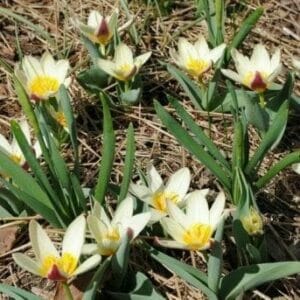The tulip has a short stem, 20–25 cm long, making it a dwarf tulip. It has lance shaped leaves which may be plain green or blue-green. They also often have purple markings on their leaves. It is one of earliest tulips to bloom between February to April. In this page we talk about Tulipa kaufmanniana | About Tulip kaufmanniana Wallpapers.
Contents
Tulipa kaufmanniana:
Colorful spring bulbs native to Asia. They have short stems and large flowers. They pair well with daffodils and look great naturalizing in a landscape or in mass planting in borders or along walkways. Plant in fall for spring blooms. It is generally a shorter plant and flowers have a yellow ‘eye’ and pointed tepals for identification.
Tulips generally decline yearly when expose to temperature above 70 degrees F. They do well when grouped and mass planted. Variegation is due to a viral infection so patterns vary greatly. It commonly known as the ‘Water-lily Tulip’. Because the petals of the flower open out like a star or waterlily. After it has flowered it will form seeds.
The funnel shaped flower has six pointy petals that open out like a star similar to water lilies do, hence the common name. They open very wide on sunny days. They usually have outermost petals with a different color than interior petals. The long upright petals often have a flushed orange red, red or purple flush on the back of the petal. Inside the petal, there maybe a butter-yellow or yellow blotch and sometimes with further red markings. There are also red, orange, pink and clear yellow forms too.
The Latin specific epithet kaufmanniana refers to Konstantin von Kaufman. He was first Governor General of Russian Turkestan where tulip found. It was first found in Turkestan and then published. It described by Eduard August von Regel in his botanical magazine ‘Gartenflora’ Vol.26 on page 194 in 1877. Also it published by Regel in Act. Hort. Petrop. Vol.5. on page 265 in 1877.
Tulip Wallpapers:
Materials:
The object of investigation was T. kaufmanniana an endemic species of the Western Tien Shan (The Red Data Book, 2019). According to the modern classification, T. kaufmanniana belongs to Tulipa subgenus and distinguished by intraspecific diversity.
T. kaufmanniana immature seeds harvested in June, 2017 from fruits 2.8-4.0 mm long within 50-54 DAA. It is well known that only one or two days after anthesis, stigma is receptive and the flowers can be pollinate. So we believe that the time of anthesis is a suitable indicator in the case of natural pollination of T. kaufmanniana.
As the excision and cultivation of globular tulip embryos is difficult, similarly to nearly mature ones. We used the embryos at torpedo stage with distinct cotyledon at the age of 52-54 DAA. They found to autonomous in their development in vitro. Seed capsules surface disinfected with 70% ethanol for 1 min, followed by immersion in a 15% solution of Domestos for 15 min and rinsing 3 times with sterile water.
Zygotic embryos isolated from seeds aseptically under a binocular microscope; these embryos taken as the explants. Embryos placed flat halfway embedded on MS medium without PGRs or supplemented with 0.3 mg L−1 NAA, 0.5 mg L−1 BAP or TDZ. Six different treatments used for T. kaufmanniana embryo culture.
Methods:
The seed productivity of mature fruit studied using procedure proposed by Vainagiy . We determined PSP (potential seed productivity) as the number of ovules; ASP (actual seed productivity) as the number of seeds. Also SP (seminification percentage) as the percentage of ovaries and SP = (ASP/PSP) x 100%.
After calculated the seed productivity, the selected seeds with viable embryos sowed in the plots with similar soil conditions. It’s during autumn before the formation of the snow cover. Embryos and seedlings were examine using Axioplan 2 imaging (Carl Zeiss) microscope and photographed. It used with the AxioCam MRc5 high resolution digital camera AxioVision 4.8 with the digital image processing software.
Conclusion:
Tulips generally decline yearly when expose to temperature above 70 degrees F. They do well when grouped and mass planted. The tulip has a short stem, 20–25 cm long, making it a dwarf tulip. It has lance shaped leaves which may be plain green or blue-green. They also often have purple markings on their leaves.


















